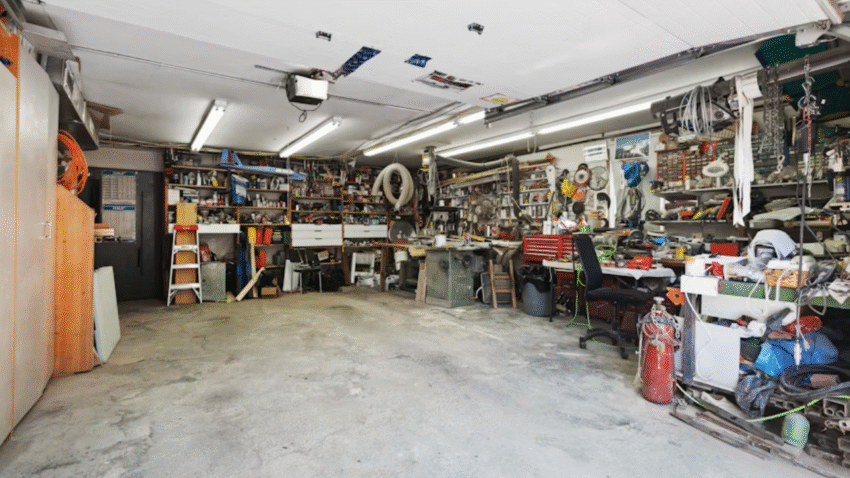Introduction
Garage shelves take a beating—holding everything from paint cans to muddy boots—and over time, they can start to look worn, faded, or stained. A fresh coat of paint is a quick and affordable way to give your garage an instant facelift while protecting the shelves from further damage. In this guide, you’ll learn how to repaint garage shelving for a fresh look, from preparation to finishing touches, so your storage space looks organized, clean, and professional.
Why Repainting Garage Shelving Matters for Your Garage
Repainting isn’t just about appearance—it also adds protection and extends the lifespan of your shelves. Here’s why it’s worth the effort:
- Improves aesthetics by giving the garage a cleaner, more organized feel.
- Protects surfaces from moisture, rust, and everyday wear.
- Increases durability for shelves exposed to heavy tools, boxes, and chemicals.
- Boosts home value with a well-maintained and functional garage.
Whether your shelves are metal, wood, or plastic, a proper repaint can make them look new again and more resistant to garage conditions.
Step-by-Step Guide to Repainting Garage Shelving
1. Choose the Right Paint and Supplies
Before you start, decide which paint is best for your shelving material:
- Metal shelves: Use a rust-inhibiting enamel paint.
- Wood shelves: Opt for durable latex or oil-based paint.
- Plastic shelves: Choose a paint formulated for plastics.
Materials & Tools Needed:
- Paint (enamel, latex, or specialty)
- Primer (rust-inhibiting for metal; stain-blocking for wood)
- Sandpaper (120–220 grit) or wire brush for metal
- Degreaser or mild detergent
- Drop cloths or plastic sheeting
- Painter’s tape
- Paintbrushes, rollers, or spray paint
- Safety goggles and gloves
2. Clear and Clean the Shelving
Remove everything from the shelves and vacuum up dust or debris. Wash the surface with a degreaser or mild detergent to remove grease, oil, and dirt. This ensures paint will adhere properly.
3. Inspect for Damage
Check for rust spots, cracks, or loose screws. Repair or tighten as needed before painting. For metal shelves with rust, use a wire brush to scrape off loose rust, then sand the area smooth.
4. Sand the Surface
Lightly sanding your shelves helps the primer and paint stick better.
- Metal: Use 120-grit sandpaper or a wire brush.
- Wood: Use 150–220 grit sandpaper to smooth the surface.
- Plastic: Lightly sand with fine grit to scuff the surface.
After sanding, wipe away dust with a damp cloth.
5. Protect Surrounding Areas
Lay down drop cloths or plastic sheeting to protect the garage floor. Use painter’s tape along wall edges or areas you don’t want painted.
6. Apply Primer
Primer ensures better paint adhesion and longer-lasting results:
- For metal, choose a rust-inhibiting primer.
- For wood, use a stain-blocking primer to prevent tannins from bleeding through.
- For plastic, select a bonding primer for slick surfaces.
Apply one coat evenly and let it dry according to the manufacturer’s instructions.
7. Paint the Shelving
Choose your application method:
- Brush or Roller: Best for wood and large, flat surfaces.
- Spray Paint: Ideal for metal shelves with intricate designs or tight spaces.
Apply thin, even coats, allowing each to dry before adding the next. Two coats are usually enough for good coverage and durability.
8. Let the Paint Cure
While paint may feel dry to the touch in a few hours, curing takes longer. Avoid placing heavy items on shelves for at least 24–48 hours to allow the paint to fully harden.
9. Reorganize Your Shelves
Once cured, return items to the shelves. Consider decluttering or using matching bins and labels to maintain that fresh, organized look.
Common Mistakes to Avoid
- Skipping Cleaning
- Problem: Dirt and grease prevent paint from sticking.
- Solution: Always clean shelves thoroughly before sanding or priming.
- Painting Over Rust
- Problem: Rust will spread under the paint.
- Solution: Remove rust completely and use a rust-inhibiting primer.
- Using the Wrong Paint Type
- Problem: The finish may peel or chip quickly.
- Solution: Match paint type to the shelving material.
- Applying Thick Coats
- Problem: Leads to drips, uneven coverage, and longer drying time.
- Solution: Apply multiple thin coats for a smooth, durable finish.
- Not Letting Paint Cure
- Problem: Items may stick to the surface or scratch the finish.
- Solution: Allow proper curing time before heavy use.
Extra Garage Tips & Hacks
- Add Shelf Liners: Protect your fresh paint job with removable liners for easy cleaning.
- Choose Light Colors: Bright colors can make the garage feel larger and more inviting.
- Label Everything: Keep your freshly painted shelves looking neat by organizing items into labeled bins.
- Related Tip: Read our guide on how to store garden tools in the garage for more organization ideas.
Conclusion
Learning how to repaint garage shelving for a fresh look is a simple DIY project that can completely transform your garage. By choosing the right paint, prepping properly, and applying even coats, you’ll have durable, good-looking shelves that make your space more functional and appealing.
Bookmark this guide to keep your garage functional, organized, and looking its best year-round.
